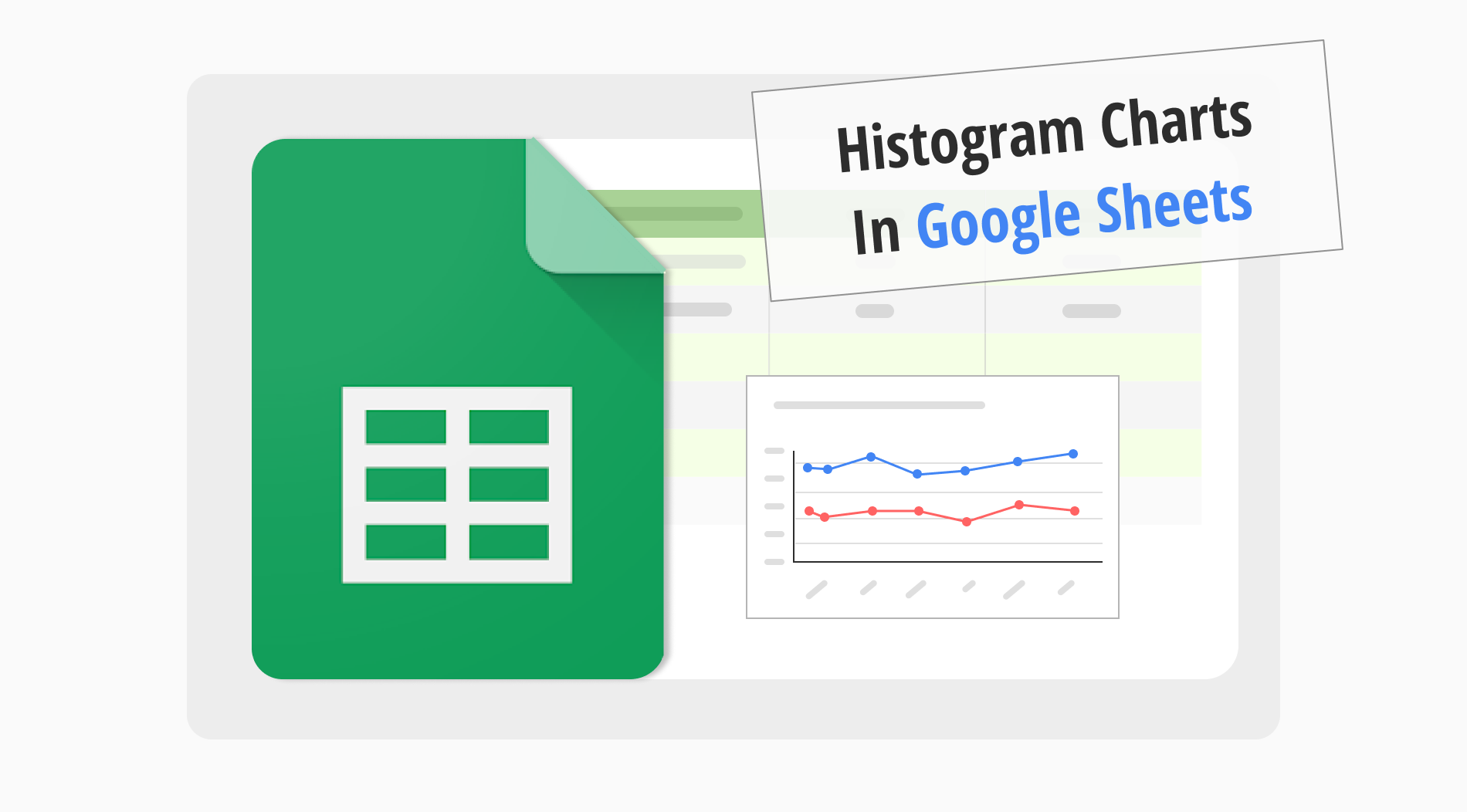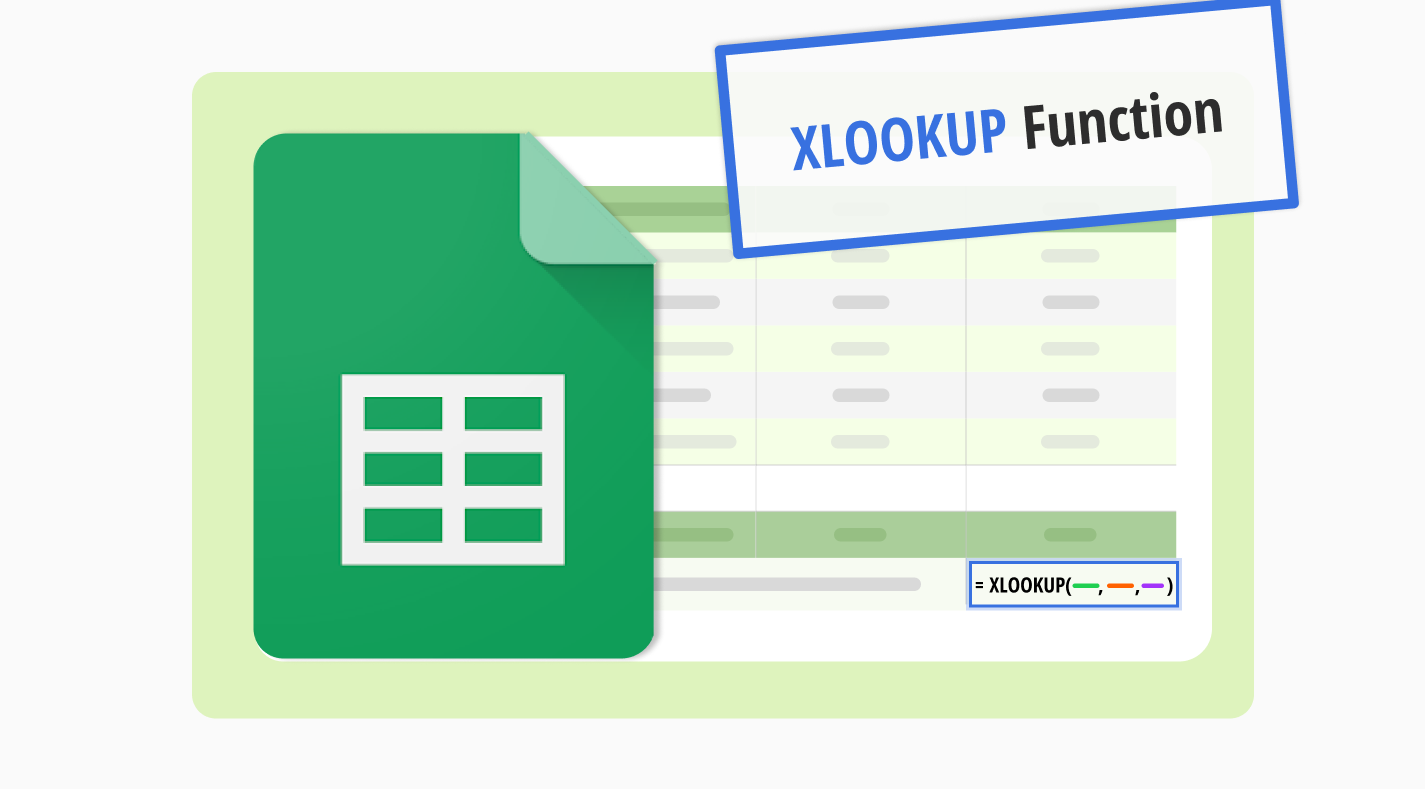
In the world of Google Sheets, it is essential to be able to find a specific piece of information quickly. The XLOOKUP function comes into play, especially when dealing with large amounts of data. This tool significantly simplifies the process of searching through data.
The XLOOKUP formula transforms how we interact with data in Google Sheets, departing from traditional lookup formulas. It offers a fast and accurate way to sift through information, boosting efficiency across tasks. In this guide, we'll walk you through the basics of using XLOOKUP in Google Sheets and guide you on how to leverage its power in your data management workflows.
What is the XLOOKUP function in Google Sheets?

The XLOOKUP function in Google Sheets is a powerful tool that searches and retrieves information with precision and flexibility.
It goes beyond the traditional VLOOKUP formula. XLOOKUP allows advanced searches, including match mode argument. If you compare XLOOKUP vs VLOOKUP, you will see a big flexibility difference in usability. An XLOOKUP example demonstrates searching in any direction. Unlikely, VLOOKUP has a vertical limit, especially when it is about direction. You can look for exact matches, approximate matches, or wildcard matches.
When to use the XLOOKUP function
XLOOKUP not only finds data but also smartly goes through it, making searches in Google Sheets faster and more precise. If you're unsure of what to look for, adding a question mark helps find close matches. This flexibility works when you work with data on lists sorted up or down, fitting perfectly into your workflow.
⏰It's invaluable for working with datasets that are neatly organized.
⏰It excels when dealing with values sorted in ascending order.
⏰It's also handy for data sorted in the opposite or descending direction.

💡For more data tips, you can check out the UNIQUE function in Google Sheets to easily clean up your data.
What's the difference between VLOOKUP and XLOOKUP?
Google Sheets formulas are lifesavers. There are various ways to ease your workflow. VLOOKUP and XLOOKUP are only two of the important formulas. They bring better flexibility and ease of use to spreadsheets. However, XLOOKUP goes beyond VLOOKUP. It allows searches in any direction. XLOOKUP also offers more advanced options. This makes finding data in Google Sheets simpler and more efficient. Here are some differences:

Differences between VLOOKUP and XLOOKUP
🎯Search direction: VLOOKUP can only search vertically (down columns), starting from the leftmost column. XLOOKUP can search both vertically and horizontally (across rows), offering greater versatility.
🎯Lookup column limitation: With VLOOKUP, the lookup value must be in the first column of the selected range, and the return value must be in a column to the right. XLOOKUP doesn't have this limitation; you can return values from any column, regardless of the lookup column's position.
🎯Default match type: If you don't specify the last argument, VLOOKUP automatically chooses an approximate match. This can cause errors if you haven't sorted the range correctly. XLOOKUP defaults to an exact match, reducing the chance of errors.
🎯Return value for not found: You can specify a custom return value in XLOOKUP if it doesn't find the lookup value. This feature is not available in VLOOKUP without being wrapped up in an error-handling function.
🎯Simplicity and readability: XLOOKUP's syntax is more straightforward, making formulas easier to read and write. With VLOOKUP, understanding and maintaining complex formulas can be more challenging, especially for new users.
🎯Performance: XLOOKUP aims for efficiency with large datasets, avoiding a search through the entire column or row after finding a match.
How to use the XLOOKUP function in Google Sheets
Using the XLOOKUP function in Google Sheets is straightforward once you understand the basics. Thanks to the formula, you specify the exact piece of data XLOOKUP should be found in your Google Sheet. Here are some steps for you to use the function:
Step 1
Begin by opening the Google Sheets document that contains the data you need to analyze.
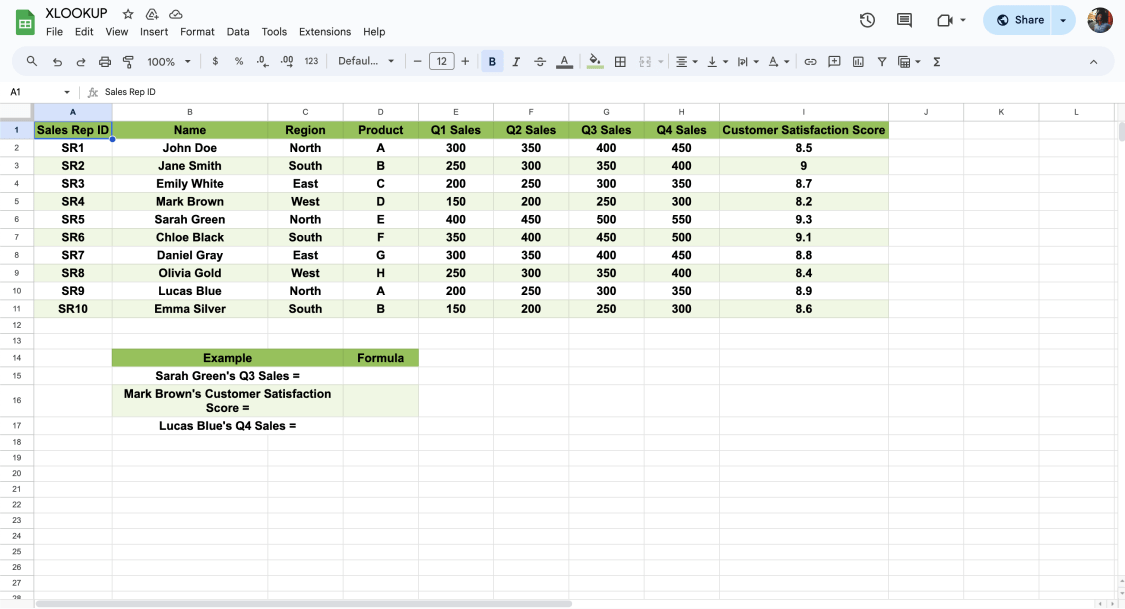
Open your sheet
Step 2
Choose a clear cell to start writing your function. Make sure the cell is empty to avoid any errors.
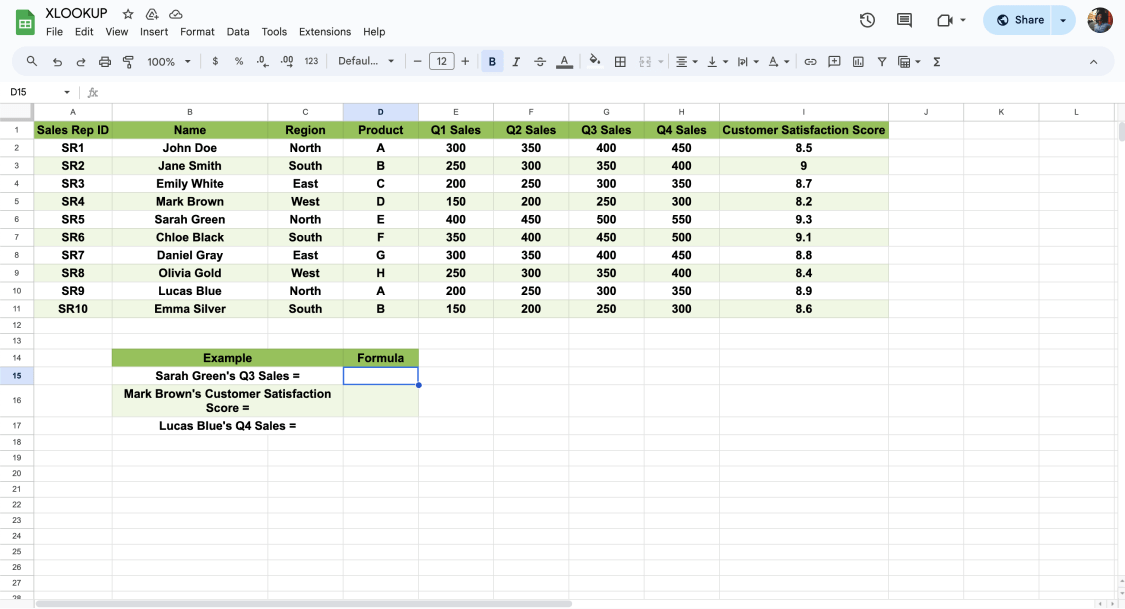
Click cell to type the formula
Step 3
Becoming familiar with the XLOOKUP function's basic formula plays a crucial role. The structure =XLOOKUP("Sarah Green", B2:B11, F2:F11) includes:
- “Sarah Green” : lookup_value: the target of your search.
- “B2:B11” : lookup_range: This is where your search unfolds.
- “F2:F11” : return_range: It is the source of your answer.
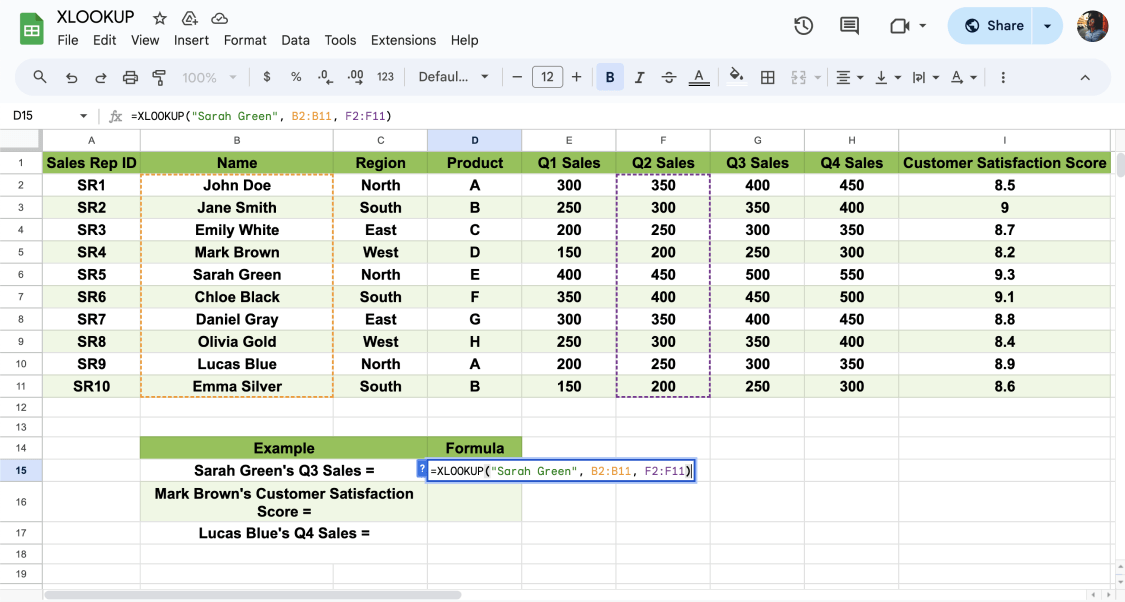
Type the formula
Optional elements add depth to your search:
- If_not_found: It offers an alternative when searches fall short.
- Match_mode: It fine-tunes the precision of your match.
- Search_mode: It guides the direction of your search.
Step 4
Now comes the exciting part—finding the information we need! With our criteria set, we input them into the XLOOKUP function. Once you're ready, type in your formula. Hit Enter, and watch as the sought-after data reveals itself on your spreadsheet.
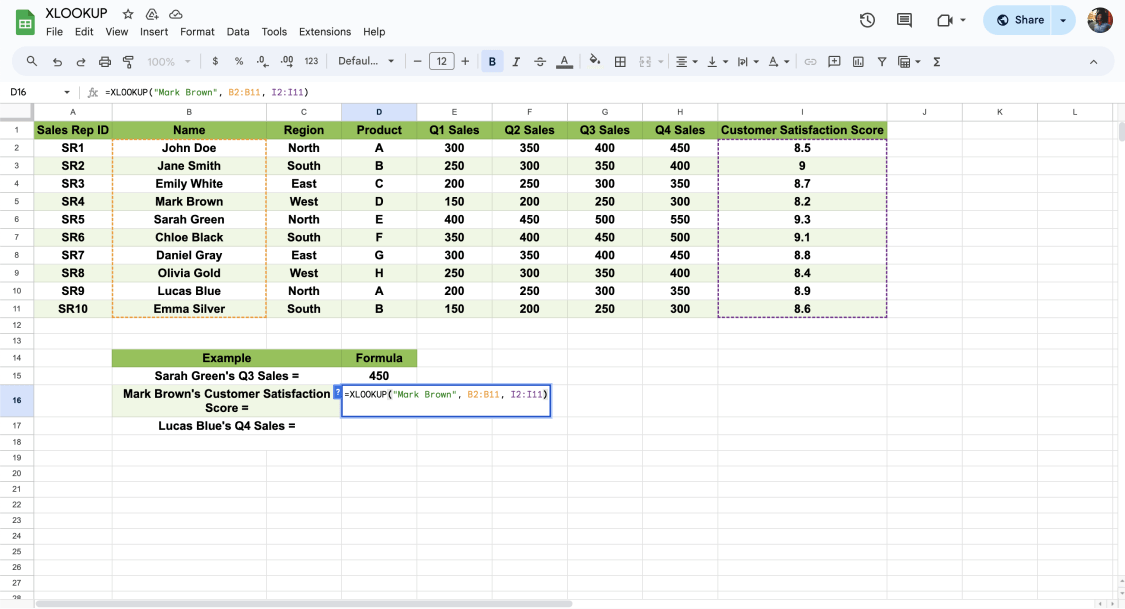
Click enter to see the result
Step 5
After successfully finding the data with XLOOKUP, it's time to review the results. Consider how you can utilize the information obtained in your analysis or reporting. This step enhances your work, allowing you to navigate complex datasets in Google Sheets more efficiently.
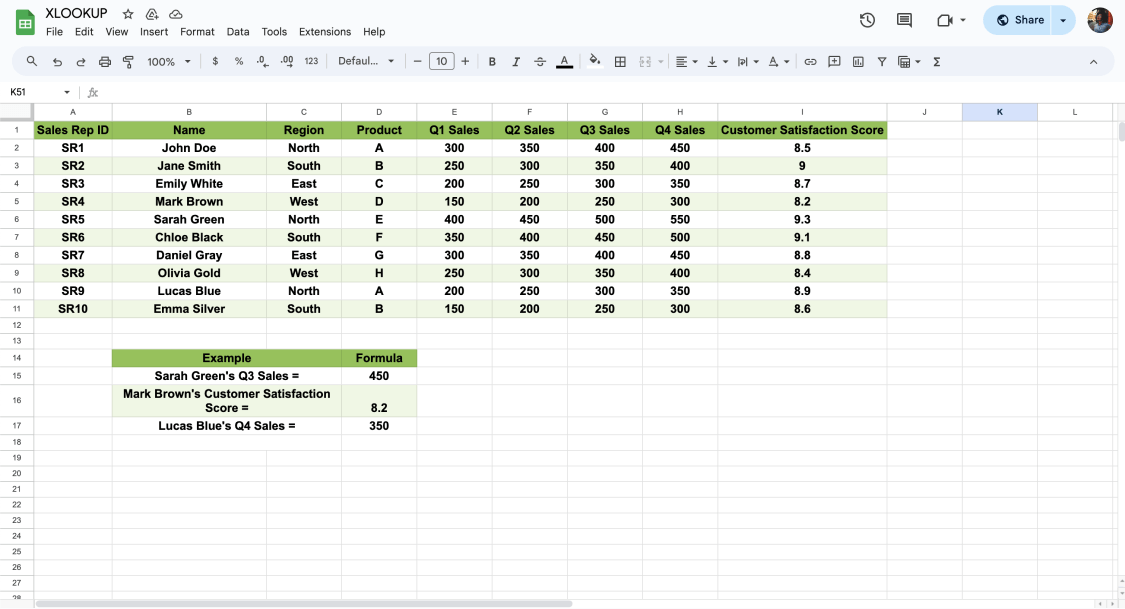
Analyze the final result
Frequently asked questions about the XLOOKUP function
Diving into XLOOKUP in Google Sheets can bring up lots of questions for beginners. This guide is easy to follow, whether you're new to it or already know a bit about the XLOOKUP function. This title aims to enhance user proficiency with the XLOOKUP function, making data management significantly more efficient.
O XLOOKUP procura um valor específico num intervalo ou matriz e devolve um valor correspondente de outro intervalo ou matriz. A utilização da função XLOOKUP permite pesquisas verticais e horizontais.
O XLOOKUP combina as capacidades do Vlookup e do Hlookup, oferecendo mais flexibilidade. Pode procurar dados em qualquer direção e encontrar itens relacionados sem as restrições das funções mais antigas.
Sim, o XLOOKUP pode tratar dois critérios quando o emparelha com funções como o filtro ou o utiliza numa fórmula de matriz. Isto permite-lhe efetuar pesquisas mais complexas que correspondem a ambas as condições especificadas.
Sim, o XLOOKUP pode trabalhar com arrays, permitindo-lhe devolver vários valores de uma só vez.
Sim, o XLOOKUP suporta caracteres curinga como o asterisco (*) e o ponto de interrogação (?), possibilitando a pesquisa de correspondências parciais.
O Xlookup está disponível no Excel para Microsoft 365 e Excel 2019. Para os utilizadores do Google Sheets, o Xlookup está prontamente disponível e não depende da versão do software.
Identifique o seu valor de pesquisa: Este é o valor que pretende encontrar na sua folha de cálculo.
Determine a sua matriz de pesquisa: Este é o intervalo de células onde o Excel irá procurar o valor de pesquisa.
Seleccione a sua matriz de retorno: Este é o intervalo de células a partir do qual o Excel devolverá o valor correspondente ao valor de pesquisa.
Escreva a fórmula Xlookup: Clique na célula onde pretende que o resultado apareça e escreva a fórmula Xlookup utilizando a sintaxe =Xlookup(lookup_value, lookup_array, return_array). Opcionalmente, pode incluir argumentos adicionais para if_not_found, match_mode e search_mode para personalizar o comportamento da função.
Pressione Enter: Depois de introduzir a fórmula, prima Enter. O Excel processará a função e exibirá o valor de retorno correspondente na célula selecionada.
O XLOOKUP permite-lhe definir um valor de retorno personalizado para quando não encontra a chave de pesquisa, facilitando o tratamento de erros.
Ao contrário da função VLOOKUP, o XLOOKUP pode facilmente devolver valores de colunas à esquerda da coluna de pesquisa, uma vez que não restringe a posição do intervalo de retorno.
Com base no modo de pesquisa que especificar, o XLOOKUP procura e devolve a primeira correspondência, uma vez que a sua conceção se centra principalmente na procura de uma única correspondência.
Para procurar dados utilizando vários critérios no Excel ou nas folhas de cálculo do Google, existem algumas opções. Os utilizadores do Excel podem utilizar as funções de índice e correspondência em conjunto para pesquisas complexas. O Planilhas Google oferece a função de filtro, que é mais simples e pode lidar facilmente com várias condições. Isto permite-lhe encontrar rapidamente os dados de que necessita, definindo mais do que uma regra para a sua pesquisa.
Last words
Exploring XLOOKUP in Google Sheets changes the game in data handling. It highlights optional arguments and the lookup value table array and moves us past the old VLOOKUP methods. These features are essential for anyone looking to sharpen their data analysis and precision.
This guide introduced XLOOKUP's advanced features and showed how to use them effectively.
Using these XLOOKUP strategies can make your projects more efficient and accurate. Optional arguments and the lookup value table array take your Google Sheets skills to the next level. These methods open up new possibilities for managing data. With these techniques, you can tap into Google Sheets' full potential for better data analysis and planning!
Behçet is a content writer at forms.app. He is a music producer and enjoys blending electronic and acoustic tunes. Behçet has expertise in Google Sheets, survey questions, and online forms.



 5 min ler
5 min ler
